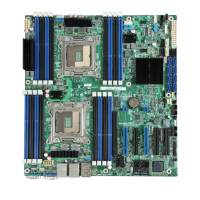Intel
®
Server System P4000CP Power System Options Intel
®
Server Board S2600CP and Server System P4000CP TPS
Revision 1.1
Intel order number G26942-003
146
13.3.5.2 Over Voltage Protection (OVP)
The power supply over voltage protection is locally sensed. The power supply shuts down and
latchs off after an over voltage condition occurs. This latch is cleared by toggling the PSON
#
signal or by an AC power interruption. The values are measured at the output of the power
supply’s connectors. The voltage does not exceed the maximum levels when measured at the
power connectors of the power supply connector during any single point of fail. The voltage
doesn’t trip any lower than the minimum levels when measured at the power connector.
12VSBwill be auto-recovered after removing OVP limit.
Table 104. Over Voltage Protection (OVP) Limits
Output voltage Min (v) Max (v)
+12V 13.3 14.5
+12VSB 13.3 14.5
13.3.5.3 Over Temperature Protection (OTP)
The power supply will be protected against over temperature conditions caused by loss of fan
cooling or excessive ambient temperature. In an OTP condition the PSU will shutdown. When
the power supply temperature drops to within specified limits, the power supply shall restore
power automatically, while the 12VSB remains always on. The OTP circuit must have built in
margin such that the power supply will not oscillate on and off due to temperature recovering
condition. The OTP trip level shall have a minimum of 4C of ambient temperature margin.
13.3.6 Control and Indicator Functions
The following sections define the input and output signals from the power supply.
Signals that can be defined as low true use the following convention: Signal# = low true.
13.3.6.1 PSON# Input Signal
The PSON
#
signal is required to remotely turn on/off the power supply. PSON
#
is an active low
signal that turns on the +12V power rail. When this signal is not pulled low by the system, or left
open, the outputs (except the +12VSB) turn off. This signal is pulled to a standby voltage by a
pull-up resistor internal to the power supply. Refer to Table 42 for the timing diagram.
Table 105. PSON# Signal Characteristic
Signal Type
Accepts an open collector/drain input from the system. Pull-up
to VSB located in power supply.
PSON# = Low ON
PSON# = High or Open OFF
MIN MAX
Logic level low (power supply ON) 0V 1.0V
Logic level high (power supply OFF) 2.0V 3.46V
Source current, Vpson = low 4mA
Power up delay: T
pson_on_delay
5msec 400msec
PWOK delay: T
pson_pwok
50msec

